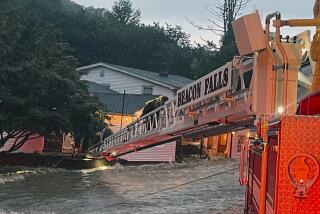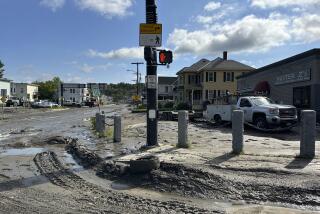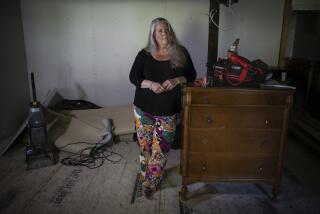Across the U.S., a winter of collapsing roofs
Reporting from New York — The first time it may have been a meteor. This time it was too much snow piled on a metal roof that took out the dinosaurs of Long Island. About half a dozen dinos, retired from the movie “Jurassic Park” and housed in a temporary building on the grounds of a museum, were crushed this week.
“They’ve been extinct a long time — and now this,” said the astonished curator of the Vanderbilt Museum in Centerport.
High winds, freezing rain, subzero temperatures and thick ice coupled with layers of packed snow have produced a phenomenon no one expected this winter: collapsing roofs around America.
Caught in the fallout have been a sports dome, a casino, schools, churches, homes under construction, historic buildings, shopping malls, sheds, gas stations and, alas, 85,000 chickens that died in a Connecticut coop that couldn’t withstand the weight of record snow falling in record time.
This Winter of the Falling Roofs seemed to start when a one-day mid-December storm dumped 20 inches of snow and brought down the Metrodome’s inflatable top on the Mall of America Field in Minneapolis, and drove the Vikings to play in Detroit.
Then came back-to-back blizzards in late December, a January ice storm and another blizzard in February that turned hundreds of what were thought be hardy structures from Maine to New Mexico into houses of cards. The relentless nasty weather seemed to do the worst damage in New England — especially to buildings with large, flat roofs, no heat and creaky rafters.
Connecticut lost 509 structures, mostly from collapsed roofs. In one week in Massachusetts, 169 buildings collapsed, according to Peter Judge of the state’s Emergency Management Agency.
“This is such an anomaly. I can’t remember a year that we had more than a few all winter,” said Judge, who has been with the agency for almost two decades.
Last week in Illinois, a church that survived the Great Chicago Fire of 1871 saw part of its roof cave in. Bricks came tumbling into the sanctuary of the 142-year-old First Baptist Congregational Church.
No people have died or been seriously injured, though many have described breathtakingly close calls.
Randy Stannard, who works at the only Gouda cheese farm in Vermont, said he went into a barn Sunday to “kick some hay” at a herd of hungry calves when he heard what sounded like a locomotive above his head.
“I looked up and saw the barn tipping over and my heart stopped,” said Stannard, 38. “I had about two seconds to make up my mind about what I was doing, and as I was running, the rafters were getting closer and closer to my head. ... I jumped from underneath the barn and was hit by the force of falling snow.”
It buried and knocked the wind out of him. “For a split second I didn’t know whether I was dead or alive. … I was feeling pain so I figured I was still alive,” Stannard said. He was able to push just the tips of two fingers above the snow and was rescued by another farmer who saw them.
Stannard ripped tendons, ligaments and muscles in his shoulders and hip but was grateful that only one of 100 cows died in the disaster. “Maybe animals can think faster than me,” he said. “They were smart enough to get out.”
If that chicken apocalypse in Connecticut wasn’t bad enough — their carcasses were incinerated — it also sparked a blog war between people with no empathy for our feathered friends and earnest animal lovers. It also revealed that the chickens were not the only ones cooped up; a whole lot of snow-bound people clearly have too much time on their hands.
“CHICKEN LITTLE WAS RIGHT. ‘The sky IS falling!!!’ ” wrote BUSTER BOB.
“85,000 chickens killed … was that a Democratic convention?” wrote Chickenhearted.
And someone named Joshua added, “SAD SAD SAD, BEEN A HECKOFA WINTER FOR EVERTHING, UGGGH AND SICK OF IT!”
New England governors have issued multiple warnings for business and homeowners to clear snow and ice from their roofs, but they may also be causing additional risks: A man in Newfane, Vt., had to be rescued after he became trapped under a pile of snow when he was raking his roof.
“We’re advising homeowners to hire folks to get up there and clear the snow,” Judge said. “The professionals get all trussed up and know what they’re doing. I’m watching guys in my neighborhood and thinking ‘Oh, I hope you’re insured.’ ”
Roofers across ritzy Fairfield County, Conn., are charging $650 for house visits and twice that amount to clear the tops of warehouses, experts said.
“Let’s just say it’s been a banner year for anyone in the snow business,” said Rich Harris of Connecticut’s Department of Emergency Management and Homeland Security.
Stannard said southern Vermont has had about enough heavy snow for one season. “There hasn’t been a day in the last three weeks when we haven’t heard about another barn collapsing,” said Stannard, noting that it was the second time in two years that the Taylor Farm, known for its award-winning cheese, lost a large barn. He said the owner was considering rebuilding, this time with steel beams.
“I guess it’s high time we stop using wood and nails for barns that protect animals,” Stannard said. “Never mind people.”
Insurance companies are expected to pay out as much as $1.4 billion from winter storm damage, according to Tim Doggett of AIR Worldwide, a Boston company that helps insurers make estimates.
“We just haven’t had any break that would lighten the loads on these roofs,” Doggett said. “Typically, we get a January thaw, but that didn’t happen and we got a lot of rain, which you’d think was a good thing because it would melt some snow, but unfortunately it just added to the weight and brought more structures down.”
And the weather drama isn’t over.
In Oklahoma, where part of the roof caved in at the Hard Rock Casino in Catoosa, the snow keeps coming. This week Tulsa, better known for pickups than snowplows, got another couple of inches, and more is on the way.
Connecticut is bracing for more this weekend, though the forecast calls for “light snow.” Which is better, unless it rains on top of that and freezes.
More to Read
Sign up for Essential California
The most important California stories and recommendations in your inbox every morning.
You may occasionally receive promotional content from the Los Angeles Times.










